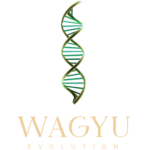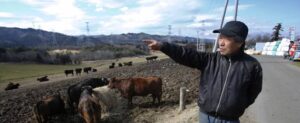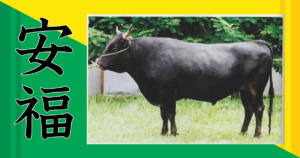History Of The Kedaka Line
Table of Contents
The second most proficient bull is Kedaka. He is the originator of the branded beef “Tottori Wagyu” and is known for his larger frame, high oleic acid content, and good mothering ability.
Tottori Prefecture – the Origin of Kedaka
In Tottori Prefecture, wagyu (Japanese beef) has been raised for a long time. The Tottori Domain has been supporting cattle farming since ancient times, starting a system called “Ushigin System” in 1695. This system provided temporary loans for purchasing cattle. Back then, cattle were called Inhaku and had become essential to daily life.
Although Tottori’s contribution is relatively small on a national scale, it has been known as a wagyu-producing region since the Edo period. In the Chugoku Mountains, iron sand was plentiful, leading to thriving iron production. Cattle were used for transportation. Additionally, Mount Daisen was revered as one of the foremost sacred mountains in western Japan. At Daisen Temple, Jizo Bodhisattva, considered the protector of cattle and horses, was enshrined, and talismans for the safety of cattle and horses were distributed.
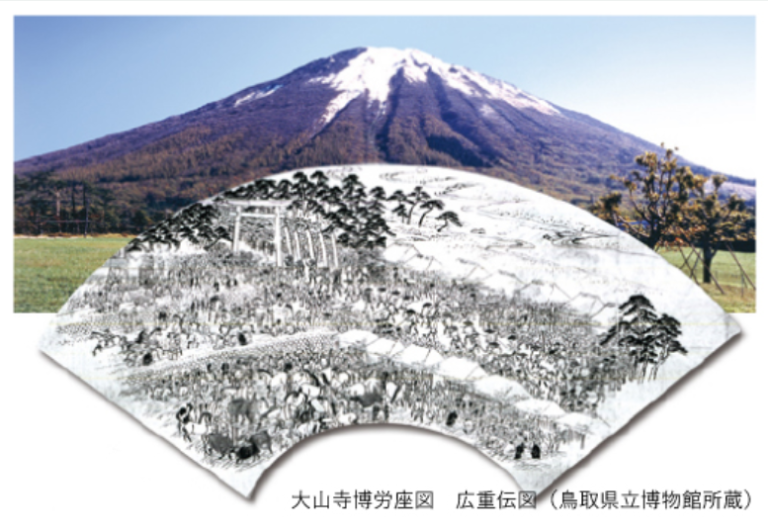
How did Wagyu Cattle Thrive in the Tottori Prefecture
In the Chugoku Mountains, iron sand was plentiful, leading to thriving iron production. Cattle were used for transportation. Additionally, Mount Daisen was revered as one of the foremost sacred mountains in western Japan. At Daisen Temple, Jizo Bodhisattva, considered the protector of cattle and horses, was enshrined, and talismans for the safety of cattle and horses were distributed.
Thanks to the teachings of the monk Kisoku Shonin, many visitors to Daisen Temple prayed for the safety of their cattle and horses, often bringing them along for worship. These visits also became opportunities for people to compare and exchange cattle and horses, leading to the establishment of the Daisen Cattle and Horse Market in Tottori.
By the Edo period, this market was one of the three largest cattle and horse markets in Japan.It is said that the event was a bustling event, with anywhere from a few thousand to 10,000 head of cattle and horses being traded each time. The company began registering Wagyu cattle as early as the Taisho era, and has continued to register bloodlines and improve cattle.
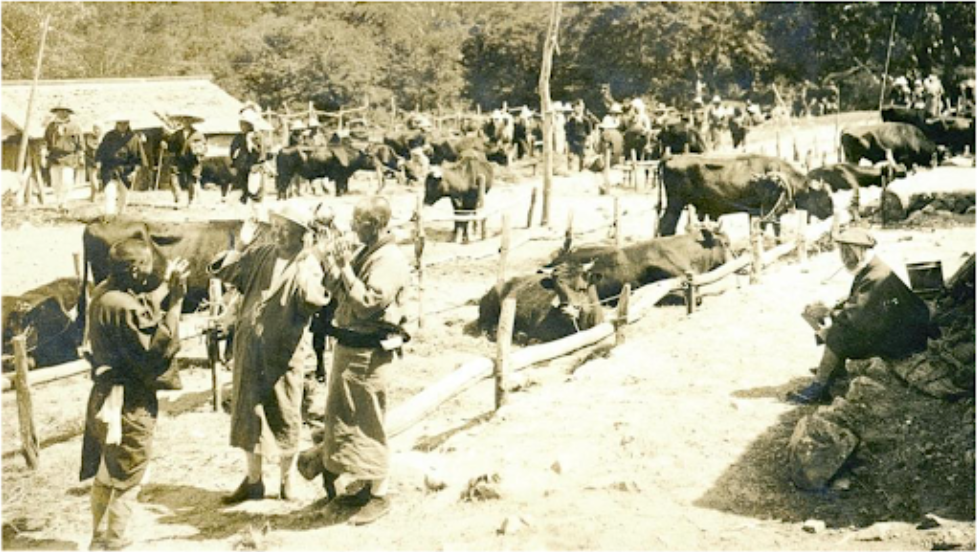
Gyuba Market at the foot of Mt. Daisen photographed in 1931 (provided by Tottori Prefecture)
The Start of Crossbreeding in Tottori
Around 1919 (Taisho 8), Tottori began breeding wagyu for meat production, registering and managing wagyu pedigrees.
The traditional wagyu breeds in Tottori, such as Inhaku, Takeda (not related to Shogo Takeda), and Hino cattle, were known for their robust health, docile nature, tolerance to extensive farming, strong limbs, and excellent meat quality. To address these, crossbreeding with foreign breeds began in the Meiji era, focusing on Brown Swiss cattle.
This resulted in hybrids with better physical development and increased milk production but also issues like excessive feed consumption and poor meat quality, making them unsuitable for small-scale farming. Economic downturns and poor hybrid performance led to a reevaluation, and Tottori decided to fix the bloodline of Inhaku cattle as the improved native breed.
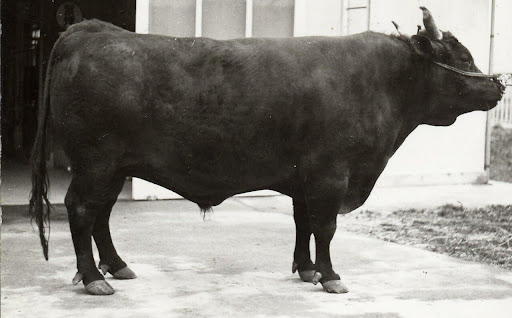
Post WWII: The Birth of Kedaka
After WWII, the efforts to refine cattle breeding continued, shifting focus from draft to beef-specific cattle due to mechanization in agriculture. During the period of establishing improved Japanese breeds (early Taisho to early Showa), they devoted themselves to fixing the blood type of Inhaku beef as an improved Japanese breed, and in 1919 they established the standard body type of the Inhaku breed. In the following year they took the lead in starting a registration project nationwide, developing Inhaku beef that was precocious and quick-maturing.
During the planned production of superior cattle (1945-1965), breeding bulls and their reproductive performance were investigated, and a planned production project was promoted by combining superior genetic factors. In this program by the Tottori Prefectural Livestock Experiment Station, the legendary bull Kedaka was born 1959. By the 1960s, Tottori implemented a comprehensive beef cattle development program, expanding breeding projects.
In the first National Wagyu Competitive Exhibition which was held in 1966, where Tottori’s breeding bull “Kedaka” won first place in the meat production division. Kedaka went on to sire nearly 9,000 offspring and is considered a progenitor of many famous sires.
Kedaka’s Lineage
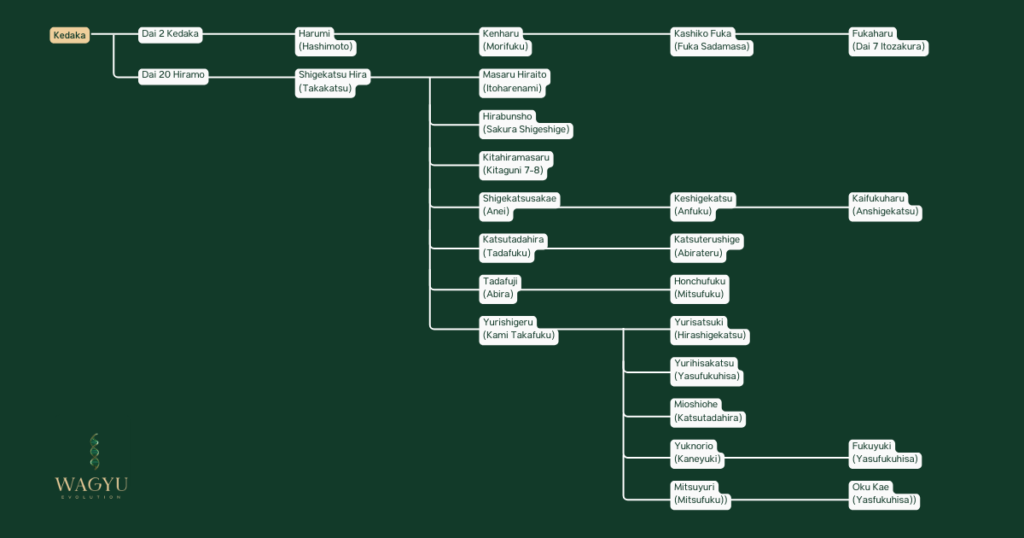
Kedaka possesses Hyogo bloodlines (Tajiri) on the dam side and is a grandson of “Eikou” (Saihaku district). He sired several outstanding sires who rose to prominence in other prefectures. “Dai 20 Hirashige,” a bull from Kagoshima prefecture, born in 1974, is widely regarded as Kedaka’s best offspring and played a significant role in the growth of the breed in the Kyushu and Tohoku areas.
As a result of research conducted by the Tottori Prefecture Livestock Experiment Station, it was found that the stronger the Kedaka lineage, the higher the oleic acid content. The content of oleic acid is greatly influenced by genetics, and in the the certification standard for Tottori Wagyu Olein 55 is that it must “inherit the lineage of Kedaka.”
Kedaka’s Offspring: Famous Breeding Bulls
In addition to Kedaka, his offspring includes other notable bulls such as “Hakuho 85-3” and “Yurishirokiyo 2”.
At the 2017 11th National Wagyu Competitive Exhibition (Zenkyo) in Miyagi, which is considered the Olympics of wagyu, Hakuho 85-3 was crowned Japan’s best. Calves descended from Kedaka are prized for their production capabilities and marbling. In 2020 (Reiwa 2), Tottori achieved the highest annual average price for wagyu calves at the Tottori Central Livestock Market.Kedaka’s bloodline is carried on by the super breeding bull “Katsuyasumi” at the Prefectural Livestock Research Station.
The Criteria for Tottori Wagyu
Tottori Wagyu is a brand of Japanese black beef raised in Tottori Prefecture. The meat quality of Tottori Wagyu, which has grown up in a natural environment, is said to be of the highest quality and boasts bloodlines of legendary breeding bulls, such as Kedaka, known for their rich fat content containing high percentages of oleic acid. Tottori wagyu must meet the following criteria:
- Black-haired wagyu fattened in Tottori Prefecture (excluding culled cows);
- Meat quality grade of 2 or higher;
- Carcasses, parts, and fresh meat traded through the Tottori Beef Sales Council, central wholesale meat markets, or the Tottori Meat Center.
Tottori Wagyu Olein 55
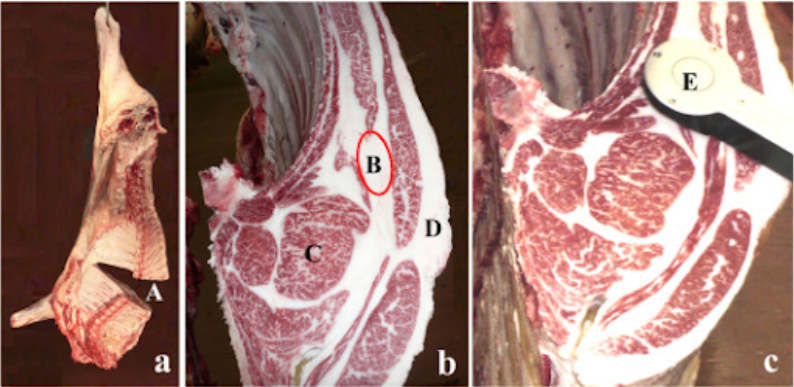
Tottori wagyu is relatively scarce, with an annual shipment of about 2,000 head, and only about 20% of these qualify as Tottori Wagyu Olein 55, resulting in roughly 400 head, making Tottori Wagyu Olein 55 even rarer. On October 13, 2020, an ordinance was established to protect and promote Tottori wagyu.
This ordinance classifies the genetic resources of Tottori’s breeding bulls as intellectual property and aims to protect and promote wagyu. The Tottori Wagyu brand is awarded only to Kuroge Wagyu beef that has passed the strict screening process by the Japan Meat Grading Association.
Tottori Wagyu Olein 55 is a brand established in 2011 with the following criteria:
- Descendant of the renowned Kedaka bull
- Contains 55% or more oleic acid
- Primarily raised in Tottori Prefecture
- Graded 4 or higher
Cattle with strong Kedaka lineage tend to have higher oleic acid content. Tottori Wagyu Olein 55 is identified by measuring intermuscular fat between the 6th and 7th ribs with a meat fat measuring device.
Inheriting Kedaka’s lineage, Tottori wagyu is rich in high-quality fat. It has a good balance of red meat and fat, and despite its marbling, it is not overly greasy and has a refined sweetness. Due to the amount of Oleic acid, a monounsaturated fat commonly found in olive oil, is an omega-9 fatty acid that resists oxidation and helps reduce LDL cholesterol levels, significantly contributing to the umami of wagyu. Tottori wagyu and Tottori Wagyu Olein 55, known for their quality and rarity, offer a unique and delectable dining experience.
Conclusion
In summary, the legacy of Tottori’s bull “Kedaka” and the meticulous standards upheld by the region’s cattle breeders. Kedaka’s lineage, known for its genetics with a heightened oleic acid content, remains foundational to the exceptional quality of Tottori Wagyu Olein 55. With a history as the first branded Wagyu, Tottori Wagyu beef continues to set the standard for premium beef worldwide, Highlighting the Importance of genetics in wagyu farming.
References
Piao, S., Okura, T., & Irie, M. (2018, March). On-site evaluation of Wagyu beef carcasses based on the monounsaturated, oleic, and saturated fatty acid composition using a handheld fiber-optic near-infrared spectrometer. Meat Science, 137, 258–264.
https://www.pref.tottori.lg.jp/item/1262230.htm
https://www.pref.tottori.lg.jp/dd.aspx?menuid=175839
https://www.yomiuri.co.jp/economy/20211227-OYT8T50114/
https://japannews.yomiuri.co.jp/original/delicious-japan/20211224-11684/
https://tottori.lin.gr.jp/chikusan/wagyu/02.htm
https://tottori.lin.gr.jp/chikusan/wagyu/04.htm
鳥取の牛
